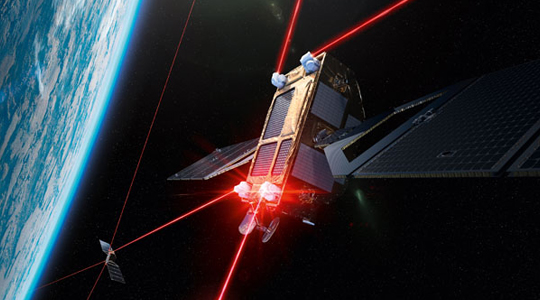 Laser dazzling is an emerging threat to space operations and space-based assets. Image shows laser crosslinks used for inter-satellite communication. (Source: Mynaric)
Laser dazzling is an emerging threat to space operations and space-based assets. Image shows laser crosslinks used for inter-satellite communication. (Source: Mynaric)
One threat Space ISAC is currently tracking that is undeniably intended for space systems is a phenomenon called laser dazzling, which is the use of powerful lasers to flood electro-optical sensors of satellites, effectively denying, degrading, and at worst destroying satellite capabilities.
According to the Defense Intelligence Agency’s 2022 Challenges to Security in Space, directed energy weapons like ground-based lasers are “designed to produce reversible or nonreversible effects against space systems to disrupt, damage or destroy enemy equipment and facilities.”
Ground-based laser capabilities pose a direct threat to on-orbit assets, specifically satellites that utilize electro-optical sensors in their payloads. This technology is common in remote sensing and earth observation satellites, which primarily observe weather patterns, radiation, and other phenomena that support essential industries like precision agriculture, environmental research and development, and commercial imaging.
Imaging, in particular, is seen as a potential motivating factor for the development of this type of technology to blind satellites from specific regions. As counterspace capabilities have advanced over the past decade, ground-based lasers are seen as an imminent threat to many ISR (Intelligence, Surveillance, and Reconnaissance) and SAR (Synthetic Aperture Radar) satellite capabilities across the world. The dependency of these critical services is seen in support of military operations in Ukraine from commercial satellite constellations providing valuable imaging services.
Increasing Anti-Satellite Capabilities
Offensive capabilities have evolved in recent years and pose a significant threat to space systems, among other non-kinetic counterspace technologies. Several nation states have demonstrated efforts to advance these types of ground-based anti-satellite laser systems and have clearly demonstrated their counterspace role. The technology has existed since the late 1980s, when U.S. Military operations “began developing an anti-satellite ground-based laser system, in part due to intelligence reports suggesting that the Soviet Union had developed a working laser system,” according to a Union of Concerned Scientists report titled, “A History of Anti-Satellite Programs”. In 2022, we are once again seeing counterspace capabilities proliferate to include the development of ground-space anti-satellite weapons that pose a direct threat to global space assets.
Read more from Space ISAC.
Explore More:
Laser: Controlling the Shape of Light, High Security Comms and More
Threat Briefing: Surge in Telecommunications Cyberattacks Pose Implications for the Global Space Industry
Threat Briefing: Analyzing Tactics, Techniques and Procedures Used by Cyber Threat Actors to Access US Space Industry
Threat Briefing: Wiper Malware: An Increasing Threat to Satellite and IoT Enabled Capabilities
